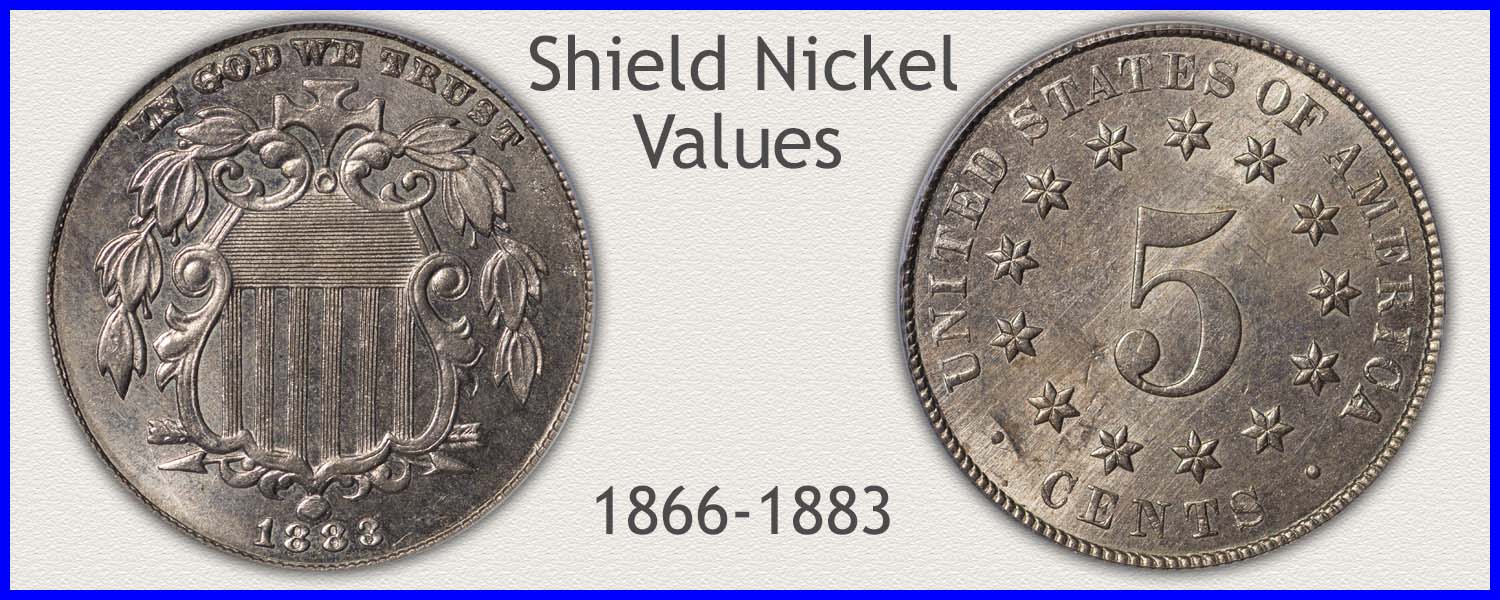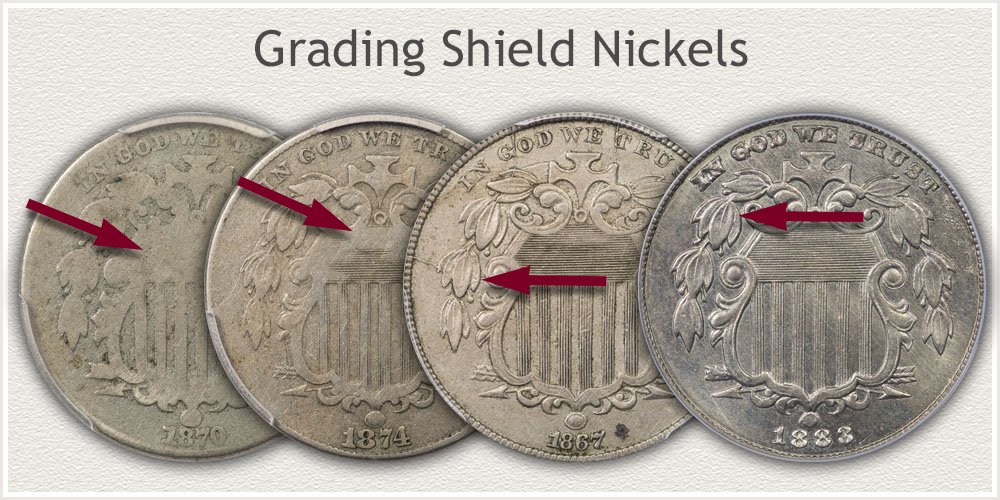Coin Values Moving with Precious Metals: Up-Dated 12/8/2025: Gold $4212 | Silver $58.12
1873 Nickel Value
Determining 1873 nickel value involves recognizing a subtle date variety. Add to the evaluation, judging its condition. Combined, these variables become part of its listing on the value chart. Keep in mind with this old series there is difficulty of finding quality examples. This shows as strong premiums.
Develop a detailed description of the coin by following a step-by-step method. When entering the coin market, key features require accuracy. Also, as part of a collection, these same features, the specific date, and the coin's grade, all help define the coin.
Special qualities include the different 1873 date varieties, recognized by comparing to images. Starting with the chart, it lists a range of how much an 1873 nickel is worth.
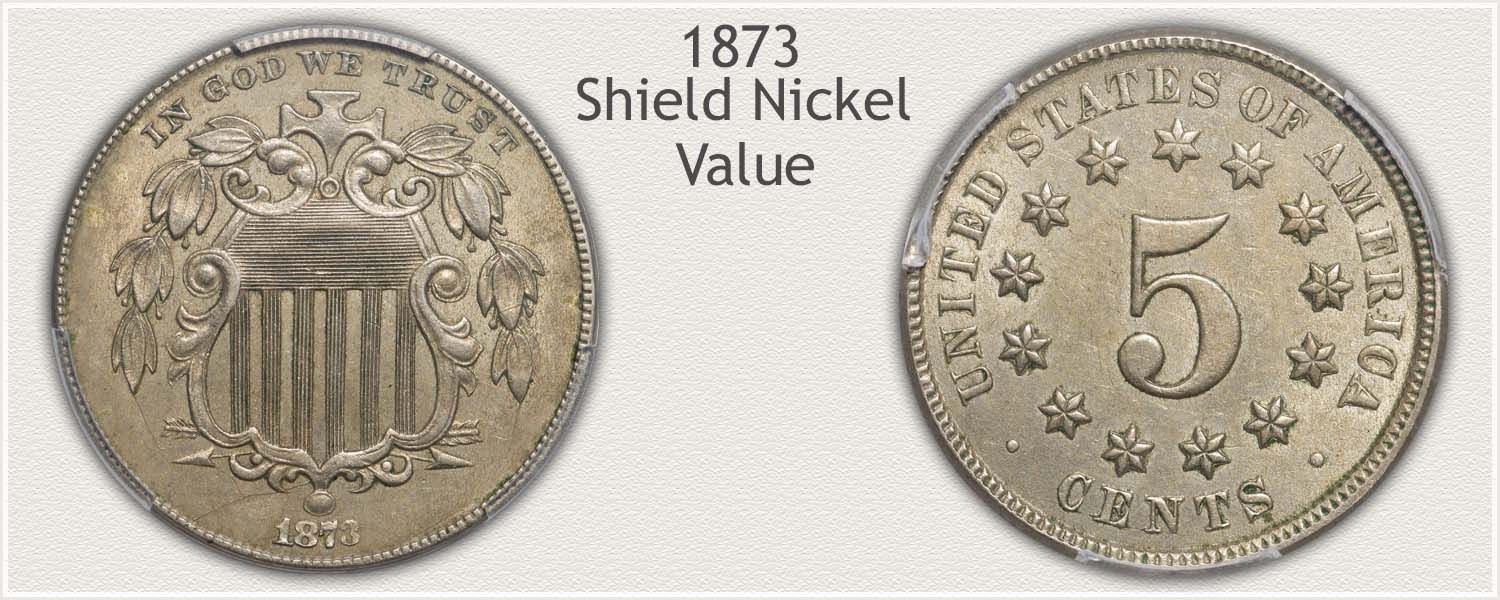
Steps Leading to Value:
- Step 1: Date Identified - There are two recognized varieties of the 1873 date, each with a different value.
- Step 2: Grading Condition - A close assessment of a coin's condition narrows its premium.
- Step 3: Special Qualities - A subtle modification in the date created a popular variety of these 1873 nickels.
| 1873 Nickel Value | ||||
|---|---|---|---|---|
| Condition of Coin | ||||
| Date | Good | Fine | Extremely Fine |
Mint State |
| 1873 Nickel Value Updated | 2025 | |||
| 1873 | $24 | $43 | $58 | $234 |
Entries in the chart represent wholesale value ranges. A slight difference in a coin's condition contributes to higher or lower premiums. Additionally, market strength and dealer needs determine how much these nickels are worth.
Step 1: An Important Year of Interest to Collectors
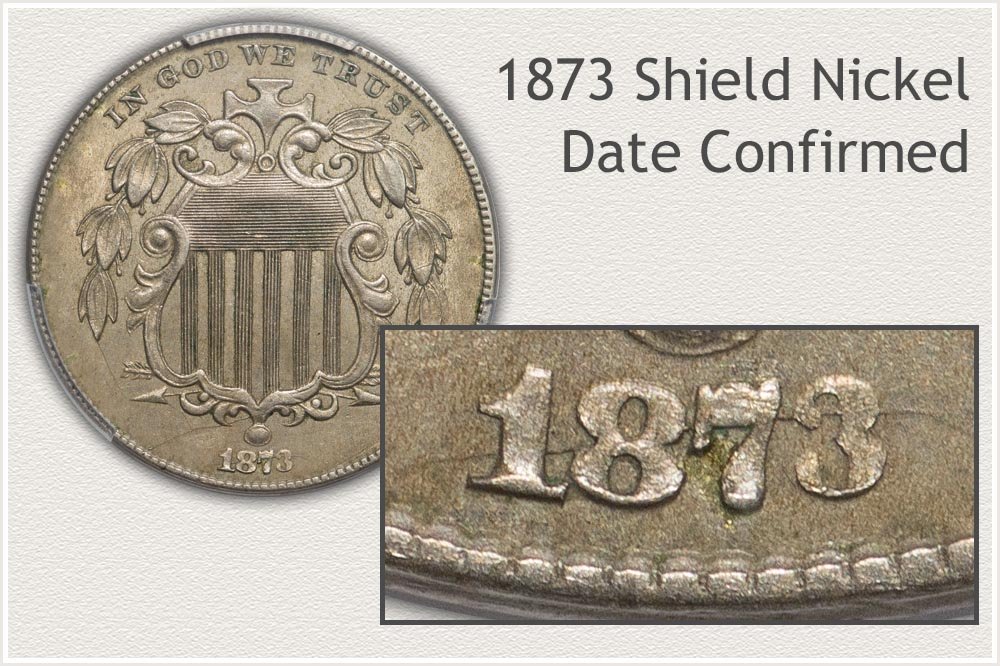
Philadelphia's production of 1873 nickels totaled 4.5 million. This included two variations of the date struck on the coins. One date displays a closed 3, making the date hard to read. A replacement open 3 helped solve the problem. The combination of low mintage and two date varieties creates interest in the coin hobby. Over time, the initial "Closed 3" variety became the difficult nickel to find. High quality examples are in strong demand, as reflected in the value chart.
Verifying the date requires a magnifying glass. Locate the very small date just below the shield. When inspecting the date, first confirm the last digit is a '3" and not an "8." Secondly, and somewhat difficult, determine the variety of the "3." Examine this subtle detail in the illustration in Step 3 below. A "Closed 3" date began the year, soon replaced with an "Open 3" later.
Demand for these 1873 nickels keeps premiums solid and adds value to the scarce date variety. Collectors studying the Shield series find each year adds more historical interest.
Step 2: | Grading Images plus Description Rate Condition into a Grade
An 1873 Nickel Requires a Close Examine to Determine a Value
Examining a Shield nickel and judging its condition narrows the value on the above chart. This grading process starts with a comparison to known graded coins. The following images are professionally graded nickels, representing market accepted grades. An unworn coin is a good choice to examine first. With all original detail intact, it provides a base from which to recognize the effects of wear.
Stages of wear produce distinct patterns on the surface. As wear continues to remove metal, rating the different stages determines its grade. These grading terms are part of a full description of the coin and key when reading value charts.
Under a single light source, begin with an overall view of the coin's surface condition. A close match to one of the grading images gets close to its grade. Inspecting areas highlighted in the grade description identifies a grade of the coin.
Mint State Grade
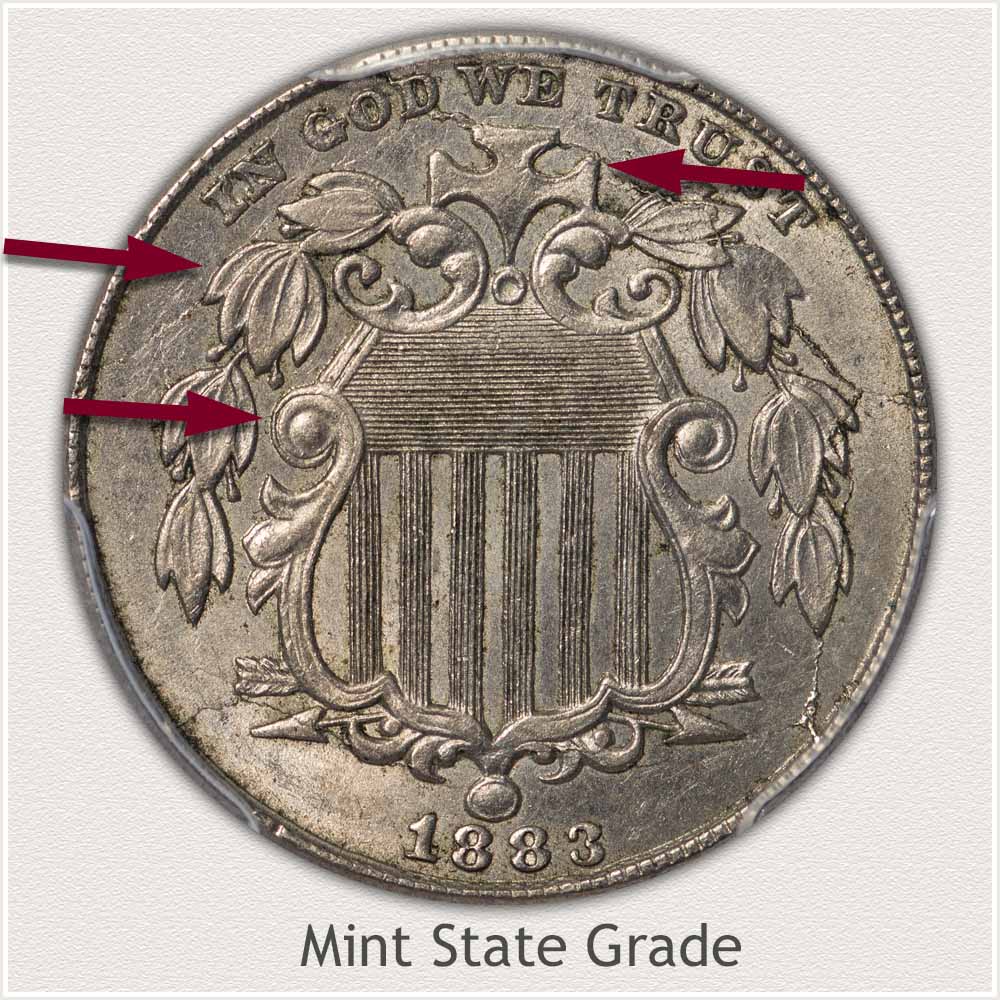
Mint State: A Shield nickel without wear to its surface defines the "Mint State" grade. This is the term used in the coin hobby and market. Without wear, these coins remain with their original surface texture. Luster radiates across the coin when tilted under a light. Luster is delicate, any breaks in luster indicates areas of wear. Three areas are typically checked to confirm a Mint State nickel. The frame of the shield, leaves, and the cross element.
A styled frame surrounds the horizontal and vertical lines of the central area of the shield. Inspect this deeply contoured frame at its highest points for wear. Fully rounded tops, with no flatness indicates an intact surface. The "ball" elements in the design, if worn, flatten across the high points. With luster remaining in these areas, the surface is without wear.
Beginning near the top, two olive branches hang either side of the shield. The deep details of the leaves present an opportunity to identify the absence of wear. High leaf ridges show signs of wear as lines of flattened metal along the edge. Within the illustration, inspect the left side leaf group near the horizontal lines. This group of leaves is well struck and clearly represents undisturbed metal.
At the very top is a cross raised high above the field of the coin. Note the texture and shine of the cross match the lower field area nearby. This field is a low point and protected from wear by the surrounding design. If both areas are similar, this confirms the high relief surface of the cross has not received any wear.
Extremely Fine Grade
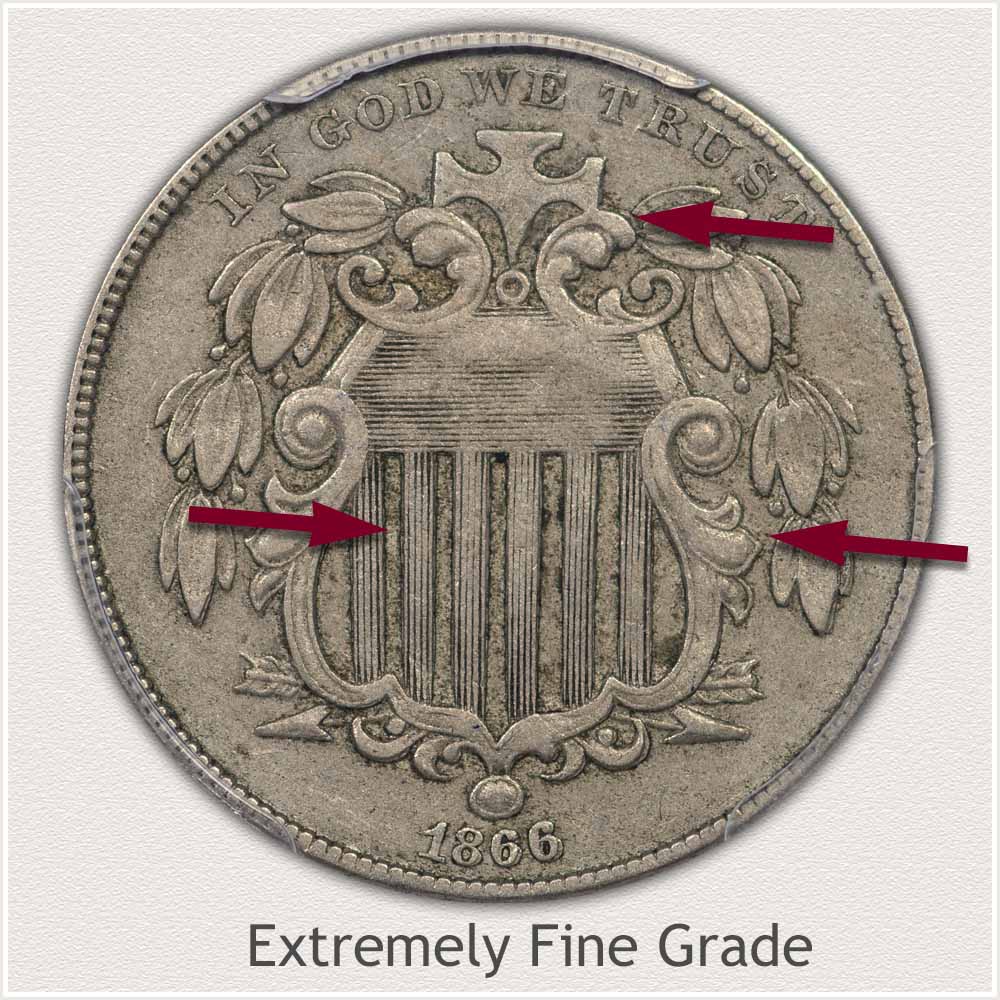
Extremely Fine: A Shield nickel in Extremely Fine grade displays high levels of detail in all areas. Slight wear appears on the high points only. All design features are distinct and minimal merging of fine lines defines the grade. When judging the grade, typical wear patterns provide measurements of the surface condition. Examine the image, it gives a good view of the minimum amount of wear determining the grade level. Collectors seek these quality coins for their aesthetic appeal. Additionally, the coin market awards this level of preservation with premium values.
Examine and then judge the frame of the shield first, and then its interior vertical lines. Using a magnifying glass, look for amounts of smooth and flattened metal. Compare to the image as you examine your coin.
Starting with the frames at the sides of the vertical stripes. These detailed features are important because they quickly show levels of wear. Light wear begins to smooth the central raised contour. Next to the raised contour, outer edges separated by a deep recess remain clear. This level of detail continues along the curved element. High levels of detail also remain on the frame below the vertical lines.
Next, the vertical lines within the shield accurately measure the amount of wear. At the Extremely Fine grade level, nearly all lines are complete and distinct. These fine lines are clearly visible despite light wear. Acceptable are small areas of limited merging and fading. Bold vertical bars and interior lines display the coin's premium quality. The image is a professionally graded Shield nickel in Extremely Fine condition. A close match with your coin determines its grade.
Fine Grade
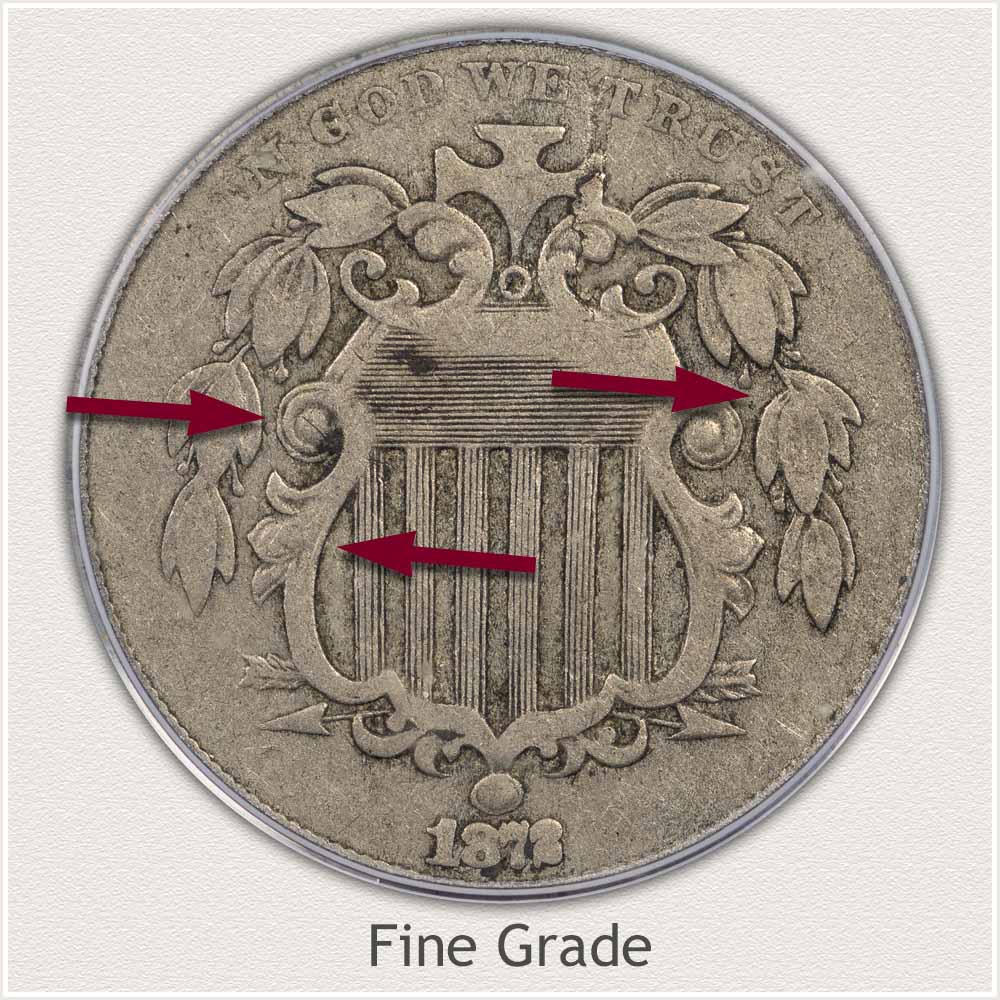
Fine Grade: A balance of visible design features balanced with flattened areas is a coin in Fine grade condition. The example Shield nickel exhibits this moderate amount of wear at the grade level. Many lower contours retain fine details, while only parts of the high points appear flat. Compare your coin with a focus on the border of the shield. Look for similarities in the level of detail and wear.
The shield's border on either side of the horizontal lines is well defined. Raised contours are visible on the spiral feature. A central ball device often shows flatness but confined to the very top. Moving downward, just below the spiral, the frame is smooth. The next raised decoration retains some contours and recesses. At the lower end of the frame is a continuous flat appearance. This combination of flat and contoured metal measures the moderate amount of wear.
Next, judge the leaf clusters located outside of the frame. At least half of the leaves show central details with contours and a central vein. Primarily, focus on the top leaf of each group. Leaves, like the frame, are a balance of flat metal with remaining detail.
Drawing the eye to the center of the coin, fine lines within the shield remain bold. Half the horizontal lines are bold, while most vertical lines are distinct. Flat areas in the horizontal lines are easily visible. Only a slight fading of vertical lines is the measurement meeting the grade standard.
Good Grade
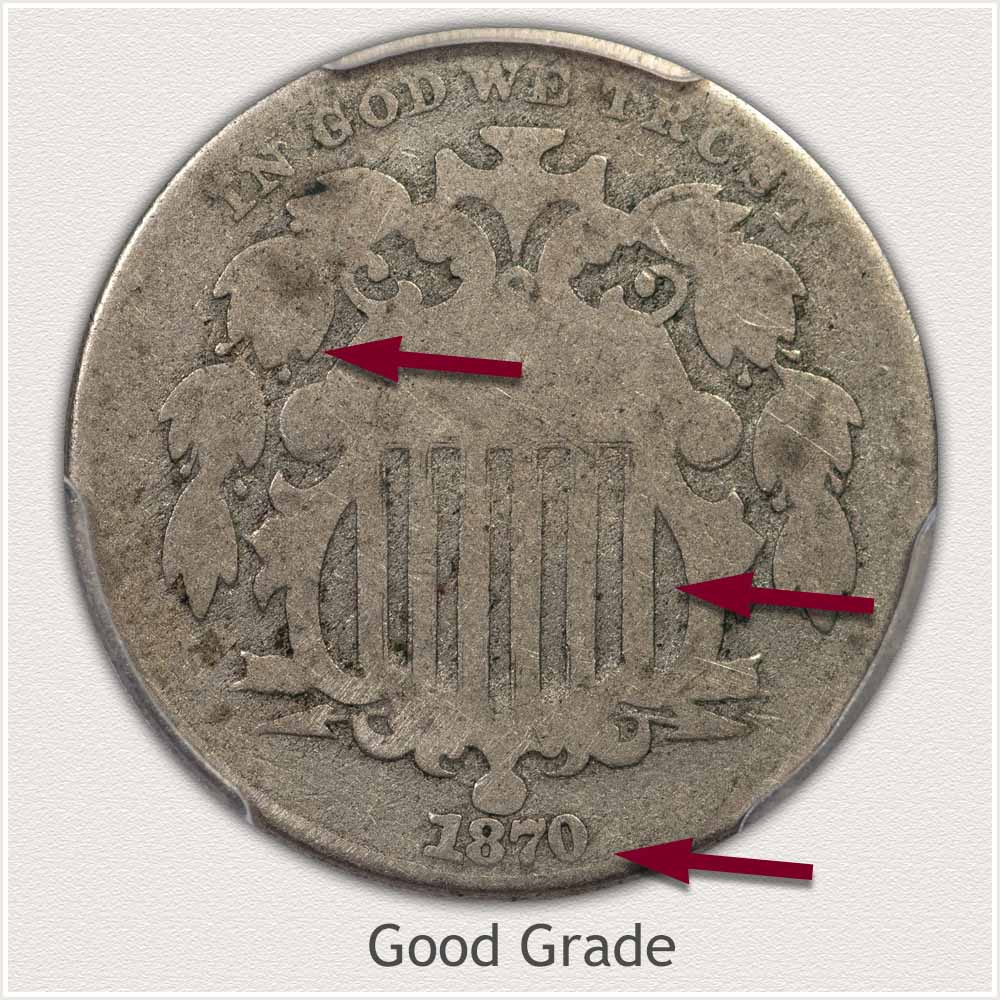
Good Grade: Examining the condition of major features on a Shield nickel judges if it is in Good grade. Flat areas on the shield, leaves, and cross are key indicators the coin is within the grade range.
Starting at the outer edge, the rim fades in places. Without a sharp inner edge, some merging with the motto IN GOD WE TRUST is acceptable at the grade level. Wear to the rim plays a role in protecting inner design areas of the coin. On the example illustrated, a partial rim at the bottom allows for a bold date. This is an important feature determining the grade.
Examine the olive branches and leaves on either side of the shield. Only the outlines of these design elements remain. All inner details are completely worn away. The leaves are smooth, lacking any texture or veining. However, it's important to note that the outer edges of the leaves are complete and not merged with the field.
Next, focus on the shield in the center of the coin. A well-worn shield is flat, missing the fine detail within its frame. Vertical stripes are a pleasing detail remaining visible and bold. Looking at the top of the shield, a cross, worn smooth, displays a bold outline. The cross only merges slightly where it meets the frame.
A Good grade nickel has a delicate balance of heavy wear and clear detail. Strong outlines of the leaves added to a bold date and clear vertical stripes are key to the grade. These offset the faded rim and slight merging with the motto. Without significant marks, scratches, or dark discoloration, these coins also have aesthetic value.
How to Video: Grading Shield Nickels
Step 3: | Special Qualities | A Scarce Date Varity to Recognize
Subtle Date Change Created Two Collectible 1873 Shield Nickels
The Philadelphia mint began 1873 production of Shield nickels with a problem. The style of the numbers used in the date is difficult to distinguish. Secondly, the size of the date is very small. Both features combined in 1873 to produce a date easily misread. The "3" appeared as an "8" at first glance.
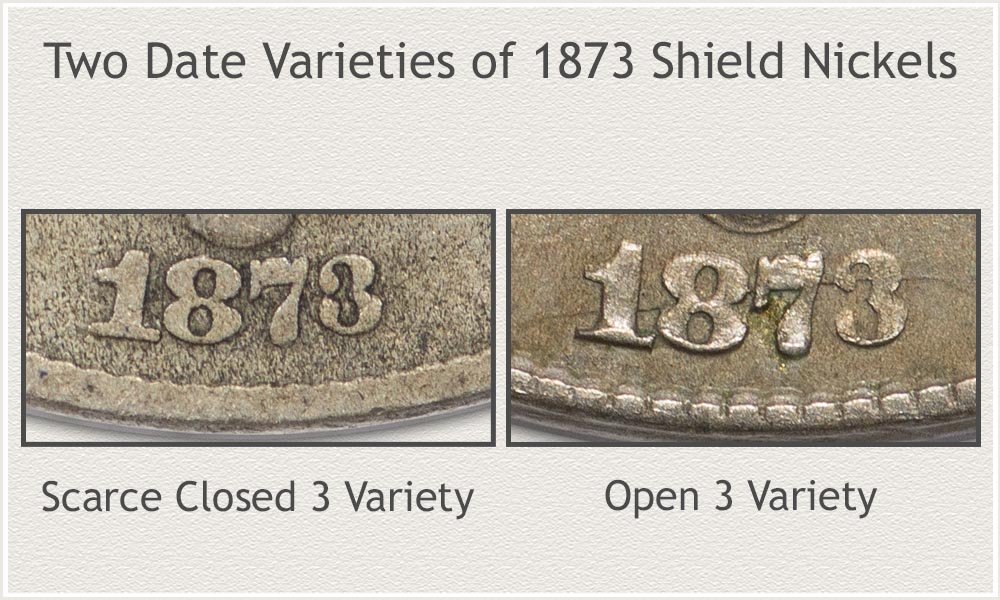 Identify the Closed 3 and Open 3 Date Varieties of 1873 Shield Nickels
Identify the Closed 3 and Open 3 Date Varieties of 1873 Shield Nickels
During the initial production, the date's "3" had a tightly spaced opening. This led to an unacceptable representation of 1873. Adopting a "3" with a greater opening made the date clearer and helped solve the problem.
Compare the two "3s" in the image. Notice the very small space indicating the "Closed 3" coin. When studied, the "Open 3" variety becomes evident. This is a subtle difference, often taking a little time to recognize.
Changing the date slightly created two date varieties of 1873 nickels. The first type minted became known as the "Closed 3" variety. The replacement, the "Open 3" variety. To determine how much the "Closed 3" variety is worth, add fifty percent to the value of the "Open 3" variety.
References
U.S. Mint. Catalogue of Coins of the United States
https://nnp.wustl.edu/library/book/554591
U.S. Mint. 1888 U.S. Mint Annual Report
https://nnp.wustl.edu/library/book/313
Coin Values | CoinStudy Articles
Date by Date
In Depth Shield Nickel Value
Shield Nickel Value | Complete Value Chart of All Years
A complete value chart lists all years, highlighting the scarce nickels. Introducing a nickel alloy five cent piece in 1868, Shield nickels are a first for U.S. coinage. Many dates in the series that ended in 1883, are scarce, if not rare.
How to Grade Shield Nickels | Visual Guide
In-depth how to grade Shield nickels. The main features of the guide cover specific areas to examine. Examine closely the amount of detail required to qualify for each grade. Additionally, reference the close-up images and descriptions when inspecting a coin's surface.
Coin Grading Services | Authenticate and Grade of Coins
High value coins are routinely sent to a grading service to authenticate and then grade the piece. The two leaders in this service are NGC and PCGS. Each provides assurance of authenticity and grade, helping narrow the value range. The variety of an 1873 is noted on the label. Market acceptance of the condition is often worth the fee to review the coin.
Selling Coins | How to Realize the Best Value
With a planned approach, organize coins for the selling process. Gather important details defining and describing the coins. Estimate their offering value. Also, listings of dealers find those making a market for the coins offered.
Safe Coin Storage | Recommendations
Recommendations on basic supplies that greatly improve coin storage. Providing for safe handling, preserving value, and organizing your box of old coins. Safely house and store old nickels and maintain their value into the future.
★Coin Values Discovery finds 1873 Nickel Value and...
All old U.S. coin values. It is an excellent index with images and text links to all coin series, from Cents to Gold. Value charts, along with a step-by-step process, uncovers how much your box of old coins is worth. Verify each coin's series, date, and special qualities.
